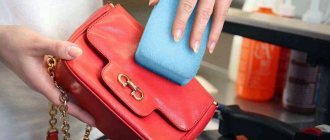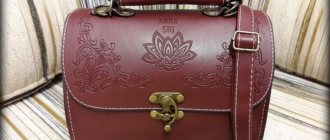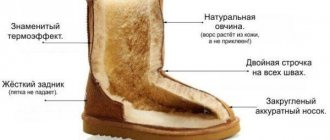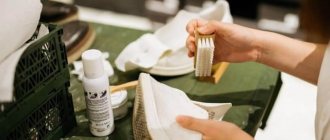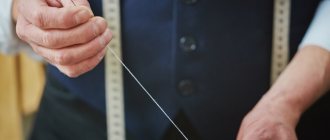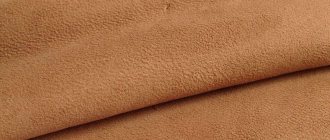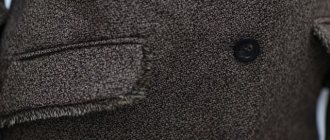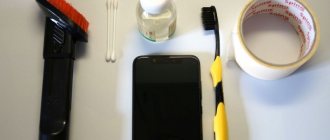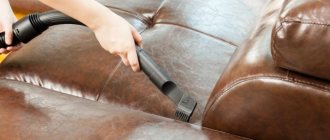Nubuck is a material made from cattle leather by tanning with mineral salts. The result is durable, fine-haired leather that is not prone to stretching (unlike suede), so it is used to make shoes and boots. But still, this is a capricious material that needs careful care. How to clean nubuck at home from dirt, dust and white marks?
Other care options
A greasy stain on a nubuck surface can be removed with talcum powder.
This product is capable of absorbing fat and is also easily removed from the surface of the material with a brush. To combat pollution, you can also use a solution of ammonia in a ratio of 1:4 or dilute a tablespoon of vinegar per liter of water. Soak a cotton pad in the solution and wipe the stained area with it. Drying after the procedure is mandatory.
On clothes and accessories made of nubuck, the places of contamination are usually the same. The bag may show signs of use in the area where it comes into contact with clothing.
On a jacket, especially a light-colored one, dark stains in the cuffs and pockets can be a real problem. Therefore, it is necessary to constantly carry out preventive measures and not allow dirt to eat into the material.
Greasy areas can be cleaned with semolina, rubbing it in and regularly replacing it with a new portion. If you need to clean the inside of your shoes and rid them of an unpleasant odor, you can use peroxide. It should be carefully sprayed over the entire inner surface of the boot. All bacteria - sources of unpleasant odor - will die from the effects of peroxide, then the shoes should be wiped with a damp cloth and left to dry.
To learn how to clean nubuck shoes using ammonia and water, see the following video.
When purchasing shoes made from this material, there should also be a care instructions in the shoe box.
If for some reason you don’t have one, the following tips will tell you how to properly clean and care for nubuck shoes:
- These shoes need to be cleaned daily, morning and evening.
- For cleaning, use only special brushes, aerosols and ointments for cleaning shoes. Leather cleaners are not suitable.
- Before cleaning, shoes should be thoroughly dried. Drying should be natural. No electric heaters!
- First, use a special brush to remove dry dirt and dust.
- If there are white stains on the shoes, remove them with a damp cloth.
- Apply a special cream of a suitable shade.
Finish cleaning your shoes by spraying with a water-repellent spray.
When buying a pair of boots or ankle boots made from specially tanned leather, you should familiarize yourself with the care rules in advance. Knowing how to clean nubuck from dirt, you can avoid annoying mistakes that can ruin your shoes.
Basic Rules
If you understand a few simple points, then wearing nubuck shoes will become pleasant, and care will not be a troublesome task:
- It is recommended to wear nubuck in dry weather.
- After returning home, you should immediately clean your shoes.
- The optimal solution is to use special care products, and in their absence, gentle folk methods can be used.
- Nubuck shoes should not be wet. This rule is the main one, since under the influence of moisture the product becomes unusable.
Dry away from heat sources and heating devices to avoid deformation.
To care for specially crafted leather products, you need to purchase special equipment. A set of useful accessories will make cleaning work easier and will not harm the delicate material.
What is the best way to clean nubuck shoes:
- Mixed bristle brushes that use a combination of metal and rubber bristles and also have stiff bristles.
- Wet wipes for shoes.
- Rubber shoe eraser.
- Stain removers and cleaners for nubuck.
- Water-repellent spray and protective impregnation.
- Color spray.
Additionally, shampoo for caring for nubuck products and sponges can be useful for wet cleaning in case of heavy soiling.
Cleaning methods
The only safe way to clean nubuck shoes is dry cleaning. Using suitable products and accessories, it is quite easy to remove dust and dirt from a porous surface, but if it gets wet, there is a possibility of contaminants being absorbed. In rare cases, wet cleaning is allowed, but care should be taken when using special shampoos, wipes and brushes for caring for nubuck.
Manufacturers of well-known shoe brands always produce separate lines of products suitable for caring for the most popular types of materials. Leather, suede, and nubuck products require the use of different compounds, so when purchasing it is better to immediately purchase a ready-made set.
How to clean nubuck:
- SALAMANDER. A Spanish brand that offers products for winter and summer care, for treating shoes in wet weather, as well as for general cleaning.
- TARRAGO. Another line of products from Spain with a wide range. Brushes, shampoos, deodorants and protective sprays for shoes are available.
- COLLONIL. High-quality German shoe cosmetics and care products, among which a special place is occupied by an eraser for erasing traces of dirt from a nubuck surface.
- SALTON. The Czech company is distinguished by its affordable price and good quality of products, with the help of which it becomes much easier to care for nubuck.
Professional shoe cosmetics and special devices have a lot of advantages, but they are expensive and may not always be at hand. There are substances in your home medicine cabinet or kitchen that will not harm delicate materials and will not require financial investment.
How to inexpensively clean nubuck boots:
- Vinegar or lemon juice. A weak acid solution will help remove dirt and refresh the color of white shoes.
- Ammonia. Contaminants are removed with a cotton swab dipped in ammonia solution.
- Salt or soda. A fresh stain can be easily removed by sprinkling it with powder and then shaking it off the shoe.
It must be remembered that when using folk remedies, proportions should be observed and the minimum possible concentration should be used.
When purchasing light-colored nubuck shoes, you need to understand in advance that maintaining the appearance will require you to spend a lot of time. Stains on light, soft leather of this type are immediately noticeable, and the characteristics of the material require caution when removing them.
Nubuck eraser
- Special eraser. Shoe care departments sell a handy elastic bar that resembles an eraser for erasing. With this eraser you can remove dark stains, stains, drops and small abrasions.
- Manicure nail file. Girls often carry nail care products with them. A nail file can not only save a broken nail, but also help get rid of stains on nubuck shoes.
- Folk remedies. Chalk, flour, talc, salt - these simple and affordable substances will easily remove dirty stains from nubuck shoes and help save your favorite shoes.
If you couldn’t get rid of the dirt right away, then when you return home, you can try cleaning the surface with steam. A steamed stain is easier to remove, but you need to act carefully.
When talking about using the wet method of cleaning nubuck shoes, it should be understood that exposing leather products to water is extremely undesirable. When wet, nubuck boots or boots become deformed, and it is not always possible to return them to their original appearance. The wet cleaning method involves either wiping the shoes with a slightly damp cloth or brush with a special care product, or gently treating the most contaminated areas with steam. These cleansing options should be used as rarely as possible, giving preference to dry methods and timely daily care.
Cleaning nubuck shoes with steam at home: it is more convenient to use a vertical clothes steamer. Modern models are distinguished by a wide range of modes and allow for delicate and targeted treatment of shoes at the site of stain formation. If such a device is not available, then a regular iron with a steam function will do, which should be used to treat a nubuck pair of shoes or boots.
We suggest you read: How to remove aphids from indoor flowers
In this case, you should protect your shoes from exposure to hot temperatures by laying a layer of fabric. After heating the device, a portion of steam should be directed to the dirty area, and after softening the top layer of dirt, wipe it off with a brush or piece of soft cloth. Steam-treated nubuck boots are dried away from heating devices, and then a special protective cream or spray with water-repellent properties is applied.
Cleaning products
In shoe stores you can find a huge selection of care products for nubuck shoes. First of all, you should pay attention to aerosols that protect the skin from dust and dirt. Aerosols can be a specific color or transparent.
Special shampoos for washing shoes are also produced. Such products perfectly remove stains and dirt from the surface of the skin.
It is also useful to purchase a special cleaning brush for your pair of boots, which will help to effectively clean the welts and lift the lint.
Of course, leather like nubuck needs a water-repellent treatment. With it, the shoes will not get wet and will last much longer.
This arsenal will allow you to quickly clean your shoes at home without radical washing. Washing dirty boots begins with drying and cleaning. If the shoes are too dirty, they are wiped with a rag and left to dry. It is very important not to dry the steam next to heating devices, as the skin may warp. To keep your boots in shape, they should be stuffed with newspaper.
When the pair has dried, remove any remaining dirt from the sole with a damp cloth, and clean the surface of the leather with a brush. To eliminate the white stains that often appear on winter shoes from moisture, you need to wash them in a special shampoo.
When the pair is washed and dried, a water-repellent impregnation is applied to the surface of the leather. If the pair has already lost its brightness of color, then before applying impregnation it must be treated with a tinting aerosol.
How to clean nubuck shoes at home
Elegant and stylish nubuck shoes, unfortunately, are extremely susceptible to dirt. Therefore, at the first appearance of any stains on it, you need to start cleaning, but this should be done with skill, so as not to spoil your favorite pair.
If you just came home from the street and found stains on your nubuck shoes, you should:
- Using a damp cloth, carefully wipe the dirt off the sole and heel,
- If the shoes are dry, clean them using a special brush for nubuck,
- The wet steam is pre-dried away from heating devices, stuffed with paper. Nubuck shoes should never be cleaned while wet, so that dirt does not get deep inside! Dry nubuck is cleaned with the already mentioned brush or sponge (if there are stains).
- After drying and cleaning the shoes or boots, they are impregnated with special products that protect them from moisture and dirt.
Impregnation of nubuck shoes is done in advance, and not before going outside. For example, this can be done in the evening, and the next morning you can put on your favorite pair.
Such a fastidious material as nubuck requires regular impregnation and cleaning with various means. Moreover, folk craftsmen adapted even widely used household substances, medicines and products for this purpose.
Typically, nubuck cleaning products are sold in shoe stores. So you can purchase a cleaning kit along with your new shoes.
Brushes come in three-sided and four-sided types. They have metallic bristles and a rubberized side.
The edge of such a brush is convenient for cleaning shoe seams. You can buy a special eraser for cleaning small stains. It cleans dirt well and does not spoil the material.
Trademarks that produce care products for such shoes: SALAMANDER (Spain), TARRAGO (Spain), COLLONIL (Germany), SALTON (Czech Republic) and others.
You can also purchase the following products:
- Liquid product of various colors for tinting the surface;
- Foaming shampoo for gentle cleaning;
- Liquid cleaner;
- Stain remover;
- Aerosol dye;
- 3-in-1 gel: impregnation, cleansing, care;
- Shoe deodorant.
Nubuck jacket
Products made from nubuck look very stylish and attractive, in addition, this material is quite durable if properly cared for.
To rid a nubuck jacket of dirt and grime, it is recommended to carry out only dry cleaning, using special products for cleaning nubuck:
- identify areas that require cleaning from dirt;
- Apply a special spray or cream for nubuck to the contaminated areas and gently rub the stain, as if rubbing the product into the material . This can be done using a soft cloth, an applicator built into the tube with the product, or a soft brush for nubuck;
- Use a rubber brush for nubuck to “comb” the pile and leave the product to dry.
In case of heavy contamination, the item can be held over steam for a few seconds immediately before removing the dirt. This will help straighten out the lint and make cleaning easier and deeper.
It should be noted that nubuck, especially natural nubuck, is a rather capricious material, so if it is very greasy, it is recommended to take the item to the dry cleaner.
Delicious recipe! Baked Canned Peaches
Nubuck: material features, types
The most common misconception among buyers of nubuck shoes is that this material is confused with suede. Meanwhile, the leather of various livestock breeds is used in production and, as a result, there is a significant difference in properties.
Characteristics of nubuck:
- Suede boots and shoes with good quality material resemble velvet, while nubuck shoes look denser and more uniform, like velor. The easiest way to notice a porous structure is when it gets wet. Nubuck can tolerate a little moisture, but if it gets too wet, a pair of shoes will be hopelessly damaged.
- Depending on the tanning and processing method of cattle leather, nubuck products may differ in density and also have an additional protective layer of oil impregnation. Thick nubuck is more often used in the production of winter boots, and a lightweight type is used in the production of shoes and sandals.
- Nubuck boots have all the advantages of leather shoes - they are warm, maintain air exchange and feel comfortable on your feet in any weather. Artificial nubuck lacks the positive properties of natural leather, but the cost of such products is much lower.
- The disadvantages of the material include poor resistance to moisture. When wet, shoes get wet, lose their shape and become impossible to restore.
An elegant pair of nubuck boots, boots or pumps will brighten up your wardrobe. You should understand how cleaning nubuck shoes differs from the rules for caring for porous materials with a similar structure, since the life of the product and the preservation of the appearance of a pair of shoes depend on this.
Nubuck is a fine-pile leather that is first chrome tanned during the tanning process, and then the upper part is sanded using materials with minimal abrasiveness. Outwardly, nubuck is similar to suede, but it is made from the skin of cattle rather than small cattle. The peculiarities of tanning determine the special pliability and at the same time wear resistance of the material. There are several types of nubuck:
- natural,
- artificial,
- nubuck oil (oiled, or hydrophobic).
Natural nubuck
This type of leather can be made from 3 types of skins - half-skin, outgrowth and calf. Half-leather is obtained from cattle older than 1 year. The offspring are produced by one-year-old calves, and the cows are made from the skin of animals under 6 months old. Naturally, the younger the animal, the softer and more flexible the skin. As already mentioned, natural nubuck is created by tanning with salts that contain chromium. Sanding the front part of the material with fine-grained sandpaper or sand makes its surface velvety and very soft.
Such nubuck perfectly allows air to pass through and retains heat. However, it is not very wear-resistant and requires periodic treatment with special impregnations and antiseptics. The most delicate leather to the touch is very popular as upholstery for upholstered furniture. However, a piece of furniture upholstered with such material is very expensive, so shoes made of nubuck have become more widespread and popular. True, in shoemaking it is still more advisable to use the oiled type of this leather, which will be discussed below.
Artificial nubuck
Artificial nubuck is a material created by spraying polymers on top of each other in several layers. This allows you to obtain a “skin” with a pile of the required length and thickness. This type of nubuck is more durable, better tolerates changes in temperature and humidity, and is scratch-resistant. By the way, synthetic origin makes it possible to create a more impressive range of colors compared to natural nubuck.
The author of the article has seen for herself that, despite all the external beauty and practicality, shoes made of artificial nubuck are not only devoid of comfort to wear, but can even be dangerous to health. So, the foot sweats a lot in it, because of this an unpleasant odor appears, like that of soldiers in tarpaulin boots. As a result, fungus may develop, which not only causes discomfort to you, but also poses a threat to the health of your household.
Of course, this artificial material does not allow air to pass through as well as real leather, but it is more practical and has found its fans. Especially attracts consumers:
- affordable price,
- external attractiveness,
- indistinguishable from natural nubuck,
- ease of care,
- Resistant to moisture and scratches.
Nubuck-oil
Oiled nubuck differs from regular nubuck only in its special water-repellent impregnation. Animal fats are most often used for processing. Nubuck-oil, unlike the classic version, is not so similar to suede - its fleecy surface looks a little moisturized. Most often, this type of leather is used to create expensive shoes designed for long-term use.
Regular leather, suede and nubuck are the most comfortable shoe materials to wear, but they have fundamental differences that may affect your choice in the store.
We suggest you read: How to wash a chair at home, tips for effective cleaning
Genuine leather is strong and durable, does not deteriorate from moisture, retains heat well in winter and is comfortable in summer. However, with long-term use of leather shoes, deep creases can form in the folded areas.
Due to special processing, nubuck of natural origin allows for better air permeability than regular leather and is soft and flexible. With proper care, it retains its excellent appearance for a long time. Shoes made of this material provide excellent warmth in winter, but if exposed to excess moisture or falling into a puddle, they may lose their excellent appearance.
Suede, as already mentioned, is made from the skins of small cattle, as well as deer, elk, etc. Unlike nubuck, this type of leather is not sanded, but is simply processed using vegetable and animal fats. This procedure makes the material exceptionally soft, elastic and porous.
Suede is less susceptible to moisture and dirt. Since the pile of this leather is of natural origin, it is longer than that of nubuck. At the same time, the latter is stronger than suede, and it also does not stretch as much, which makes shoes made from it more comfortable and durable.
It’s interesting that very often even store sellers confuse shoes made of suede and nubuck, without making a difference between them. However, experts confidently say that it is preferable to wear nubuck on your feet, because... it is stronger, and accessories can be purchased from suede.
In order to understand how to properly clean a thing made from a particular material, you need to learn about all its characteristics and distinctive features. Nubuck is a natural material made from cattle leather and treated by chrome tanning.
The front side of the material is treated with small particles of sand or special sandpaper, due to which a fine pile is formed on it.
Nubuck is often confused with suede, but it has a shorter pile and is not subject to stretching during wear. Both of these materials allow air to pass through perfectly, but do not tolerate moisture at all. Therefore, before any care procedures, you must first remove obvious traces of dirt, and then be sure to thoroughly dry your shoes or other nubuck item.
Products must be dried at room temperature without using heating appliances. Under no circumstances should you wash nubuck items in a washing machine or use wet cleaning methods. Failure to comply with this condition can greatly spoil the appearance of the nubuck item, which will render it unusable.
In addition to natural material, synthetic nubuck is also used in the production of clothing and accessories. Made from artificial leather, this material is less susceptible to getting wet, but at the same time it is incapable of allowing air to pass through.
Products made from artificial material can be washed in a washing machine, but only at a temperature not exceeding 40°C and with a gentle spin function. To restore the appearance of an item after washing, you should hold it over steam. Then the pile will straighten out from exposure to steam, and it can be combed with a brush.
Shoe restoration
If you didn't know how to clean nubuck shoes and didn't take care of them properly, the shoes will lose their appearance.
You can revive nubuck shoes that have lost their shine in the same way as cleaning suede shoes.
Both of these materials get a second life after steam treatment.
- Hold the shoes over the boiling kettle for a while.
- Dry.
- Go over the pile with a rubber brush.
- Apply a special cream.
- Treat with water-repellent spray.
If home cleaning is not successful, use dry cleaning services and take your nubuck shoes to professionals.
Dry cleaning of nubuck shoes consists of several stages:
- The entire surface of the shoe is cleaned.
- Salt stains, stubborn stains, and dull color are eliminated.
- If necessary, shoes are tinted.
- Shoes are impregnated with water-repellent agents.
The difficult care of nubuck shoes is completely worth it because such shoes, with proper care, are beautiful and natural.
This is a natural material that can allow moisture to pass through and “breathe” - it does not harm health. And nubuck oil is suitable for people leading an active lifestyle
Scuffs or “bald patches” greatly spoil the appearance of nubuck shoes or boots. A mark may remain after a trip in public transport or your own car, and sometimes the reason is improper care. On light nubuck such changes are less noticeable, but dark material reveals all the errors, while the shoes look worn and unkempt. In this case, it is difficult to restore the appearance of a pair of shoes, but you can try using proven tips.
Paint for shoes
- A special eraser for caring for nubuck products is used if you need to get rid of scuffs that outwardly differ in color from the main tone of the shoe.
- To raise the pile and cover the bald patch area, it is recommended to use a fine nail file.
- If the nubuck has suffered significantly and the color changes are very noticeable, then it is worth trying to paint over this area with shoe paint.
Restoration efforts may not be successful, in which case you should entrust the work to a professional and take the nubuck shoe pair to a workshop for restoration.
Rules for caring for nubuck shoes
Choosing the right nubuck care product, following the instructions for use and gentle regular cleaning will help maintain the appearance of your purchased pair of shoes for a long time. Usually the instructions are in the box with new shoes or boots, but if they are not there, then general rules will come to the rescue:
- Before the first use, nubuck shoes are treated with a special product, which should be purchased at the same shoe store.
- You should make it a rule that the impregnation should be applied the night before so that the composition is absorbed into the leather and forms a thin, durable film on the surface of the boots.
- Nubuck shoes are intended to be worn in dry weather, that is, you should not walk in puddles and wet snow in them, and should also be protected from rain.
- After returning home, the boots should be cleaned of dust using a special brush. First you need to comb the pile against the grain, and then smooth the fibers with the other side of the brush.
- Nubuck shoes may be stored in cardboard boxes placed in a dry, ventilated area. In this case, you periodically need to take out a pair of shoes, check for moths and clean them from dust.
- It is not allowed to clean nubuck products with compositions for cleaning leather, suede and other materials. You should use nubuck care products that can be purchased in specialized stores.
- To make it easier to maintain the attractive appearance of light-colored nubuck shoes, you should buy a special shoe eraser that can easily remove dark stains and drops, as well as other types of dirt.
Shoes should be stored in boxes
Following these simple rules, which are also suitable for caring for bags, belts and other nubuck products, will help preserve the purchased item and extend its service life. The capricious material requires special treatment, but the reward for the time spent will be an impeccable appearance and elegance.
Nubuck products - boots, shoes, bags, belts - belong to the category of difficult-to-care items. Natural nubuck requires careful handling and compliance with mandatory operating rules. With the help of these tips and the right products, caring for your shoes is much easier. Over time, these actions become a habit, and then they no longer require much effort.
We invite you to familiarize yourself with the TOP 7 best bed linen manufacturers
To increase the wear resistance of nubuck shoes, they should be prepared for use immediately after purchase. In addition, from time to time, shoes made of fuzzy leather need to be treated with special products. There are proven methods for caring for shoes made from natural and artificial materials, as well as methods for emergency resuscitation of footwear damaged by bad weather.
To care for nubuck shoes, you need to use special products and tools. Worth purchasing:
- A brush with metal or brass teeth. Such a tool allows you to remove dirt stains, remove debris from the surface, and treat shiny areas. Sometimes such brushes are equipped with polypropylene bristles. It’s great if the device combines several types of bristles and also has a narrow row of teeth along the edges to clean seams.
- A brush with rubber teeth - as a rule, they are tubes or wavy protrusions.
- Eraser. To care for shoes made of fleecy leather, use an eraser made of rubber and foam rubber. Usually the device is double-sided - it has a smooth and rough side. Eliminates dirt streaks, salt marks and even minor scratches.
- Shampoo. To wash sneakers, use cream shampoo for suede, velor and nubuck. This product will help remove dirt and salt traces. It is applied using a sponge, which is included in the kit, then the shoes are treated with a brush. A separate type of shampoo is cleaning foam.
- Impregnation. The special composition of the product protects shoes from getting wet, helps increase the service life of boots, and is used to restore color. The impregnation is produced in aerosol cans; it is applied quite simply - using a sprayer. During processing of products, an unpleasant odor appears, so it is important to first remove the laces and remove clothing from the affected area. If the product gets on your pants, you will have to wash them in the washing machine to get rid of the smell.
To increase the wear resistance of sandals or shoes, to avoid the most common problems - getting wet, stains, salt marks, it is advisable to treat a new pair with impregnation after purchase. To do this, apply the spray to the top of the shoes from a distance of 20–25 cm. Then repeat the procedure two more times with an interval of half an hour.
Experts recommend cleaning your shoes in the evening, before the dirt dries on them. Daily care at home includes the following activities:
- Cleaning from adhering dirt and dust. To do this, you should use a dry shoe brush.
- Removing scratches with an eraser, treating shiny areas with a brush with metal bristles.
- Cleaning seams.
- After this, the shoes should be dried and impregnation for nubuck and suede should be applied to a clean, dry surface - it will help remove stains and restore the appearance of the pair, giving it water-repellent properties.
Light-colored shoes require special care. An important condition: aerosols and shampoos must be marked that these products do not contain dyes and are suitable for the care of white, beige or yellow skin. Such shoes should not be treated with impregnation if they contain dyes. In addition, cleaning white boots with a washcloth and detergent is also undesirable - after water gets on the leather, stains and stains may remain on it.
A great way to refresh and clean lightly soiled white, beige or tan shoes is to use cleaning foam. Such products are produced in the form of an aerosol and are applied by spraying. The foam will collect all the dirt from the pile, then you need to remove it with a sponge and dry the product. This product will not make the steam wet, but a little moisture after treatment can make the surface a little darker. After 1–2 hours, the nubuck will lighten again.
Grease for smooth, greased leather
Grease nubuck is wear-resistant, but a pair of such material still requires care. After cleaning the products from dirt and dust, you need to apply shoe wax or greasy cream to the surface. You need to smear with your fingers, wrapping them in a napkin. This will help soften the wax so that it spreads more evenly over the surface.
Then the skin should be cleaned with a brush with brass bristles, helping the cream to be better absorbed. In addition, the brush will straighten the stuck together fibers and give the affected areas their original appearance.
There are traditional methods for removing grease and dust from suede and nubuck shoes. Fine salt works well on shiny areas on black shoes, and talc or starch is used to treat light-colored shoes. The bulk substance should be applied to the surface, which should then be cleaned with a brush.
It is more difficult to remove traces of paint from nubuck shoes. In this case, it is better to use a brush with metal bristles or a solvent for cleaning. It is important to understand that the latter option is fraught with the appearance of areas devoid of paint on the surface. It is advisable to remove salt stains using shampoo or cleansing foam. Other methods are ineffective compared to this.
Bolognese jacket
Bolognese fabric is a fairly lightweight and practical material from which stains and grime can be easily removed.
It is recommended to remove stains before the main wash of the product:
- highlight the dirtiest areas;
- moisten a cotton pad with warm water and gently rub the stain;
- apply a little stain remover to a soft cloth and wipe the greasy areas with it several times , trying to avoid strong friction and excessive pressure on the product;
- after the area is dry, put the item in the washing machine.
Cleaning in the washing machine:
- turn the product inside out , having first removed all items from the pockets and fastened the zippers;
- set the delicate or hand wash mode and temperature to 30 degrees;
- pour liquid detergent - gel or liquid powder into the appropriate compartment;
- reduce the speed of push-ups to a minimum.
In addition, this item can be effectively removed from dirt and dust by hand washing. To do this, you will need to dilute a liquid detergent in warm water and, immersing the product in a soapy solution, carefully saturate the entire item with it and leave to soak for 15 minutes. Then, using a soft brush, gently rub the jacket, then rinse the item until the soap suds are completely washed away.
How to clean nubuck shoes at home
To care for this finicky matter, you should acquire special tools and products that will help you effectively and quickly remove any dirt.
A double-sided brush with metal bristles on one side and a rubber attachment on the other side will become an indispensable assistant in the fight against fresh traces of dirt. The bristles are used to clean the material itself, and it is better to go along the seams with the rubber side or end, which can better remove dust without damaging the material.
In order to remove a stain, a light streak from snow, or to clean nubuck shoes more thoroughly, use special shampoos or foam cleaners. For proper care, these products are used 2-3 times a year. You can also easily clean a nubuck bag or jacket with these products.
To do this, you need to take a piece of flannel material, apply the product to it and treat the problem area. After waiting a few minutes, remove any remaining product with an absorbent cloth. After this, the product must be dried and the pile combed with a special brush.
To update the color of the material, you should have an aerosol for nubuck on hand. This product should be used as needed. The aerosol also helps to successfully mask old stains that were not removed in time and are unlikely to be removed without the help of dry cleaning.
Waterproof impregnation protects nubuck items from getting wet. This product is especially relevant for shoes. Impregnation is applied to only the purchased item, then again after the first layer has dried.
Cleaning dirt
Before cleaning nubuck, it is advisable to purchase the following products:
- A 2-in-1 brush with metal bristles on one side and a rubber insert on the other.
- Shampoo or foam cleaner for shoes, it is used 2-3 times a year for general cleaning of stubborn dirt. Suitable brands include Shampoo Collonil, Twist, Tarrago, Saphir, Sitil.
- Color restoring aerosol is used as needed. You can purchase Waterstop, Twist, Salamander, etc.
All this is applied depending on the degree and type of pollution. Dust and road dirt can be brushed off with a 2-in-1 brush, but you need to do it correctly. First, go over the nubuck with the rubber side. Hold the brush at an angle to the material and brush in one direction - this way you can get rid of dirt, grease, and refresh the appearance of the product. You can clean the joint between the nubuck and the sole using the side surface of the brush. Finish by treating the boots with the bristly side. Nylon fibers will lift the pile and sweep away dust. Dry clean your shoes after each use.
More stubborn stains, as well as white stains on the surface, require the use of shoe shampoo or cleaning foam. Apply the product to a flannel cloth and treat the problem area with it. It usually takes 2-3 minutes for the composition to take effect. After this, remove the residue with a flannel cloth or other absorbent material. Then you can dry the shoes and comb the lint with the rubber side of the brush.
Dry clean your shoes after each use.
Grease stains can be removed using talcum powder. The product will absorb the grease, and the residue can be removed with a brush. At home, you can also try gentle methods - an aqueous solution of ammonia (1:4) or vinegar (1 tbsp per 1 liter of water). Dip a cotton swab into the mixture and rub the contaminated area with it. But remember that it is harmful for nubuck to come into contact with moisture for a long time, so after cleaning the shoes need to be dried.
Old stains require the use of a solvent, but at home you will most likely ruin the nubuck. Therefore, it is easier to disguise such a stain than to remove it. Brush the boots thoroughly with nylon bristles to lift the pile, and then spray paint the stained area. After this, the shoes should dry.
How to paint nubuck
If scratches have formed on the shoes or, for various reasons, the color of the leather has changed in certain areas, many owners of nubuck items decide to dye it. For successful painting you should:
- Dry the nubuck product thoroughly,
- Clean it from dust and dirt using special or improvised means,
- To remove the water-repellent film, wipe the nubuck with the rubber part of the eraser,
- The product is dried again
- The skin is covered with paint,
- Nubuck is dried and coated with impregnation.
If you purchased an aerosol paint, the can should be kept at a distance of 15–20 cm during application so that the color turns out natural and goes on evenly. Painting is carried out in a well-ventilated area or outdoors. In order not to paint the sole and stitching threads along with the leather, many people prefer to use cream paint.
The author’s experience suggests that if you don’t want to ruin half the furniture in the room with paint and show off colored spots on your hands, the painting procedure should be done on the balcony or street, if your home allows it. Moreover, gloves should be put on your hands, and normal clothes, even home clothes, should be replaced with rags intended for disposal. For ease of work, the shoes themselves can be placed on a stool covered with newspaper or oilcloth.
